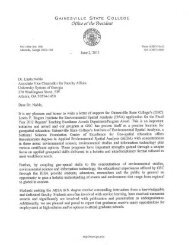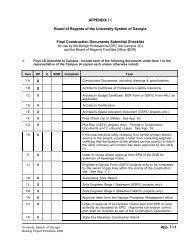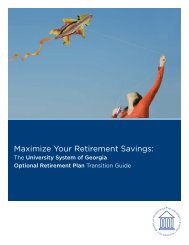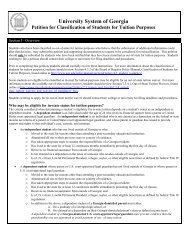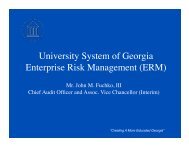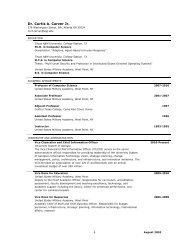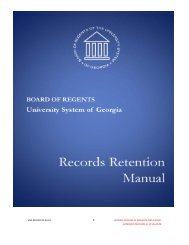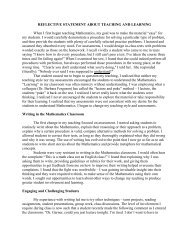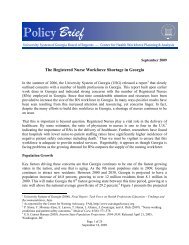66970 Federal Register / Vol. 75, No. 209 / Friday, October 29, 2010 / Rules and Regulationsevidence that the student transferred to ahigher credentialed program at anotherinstitution. To ensure the information isaccessible, § 668.6(b) has been revised torequire an institution to provide a prominentand direct link to information about aprogram on the home page <strong>of</strong> its Web site andon other pages where general, academic, oradmissions information is provided about theprogram. The information must also beprovided in promotional materials conveyedto prospective students. The informationmust be provided in a simple and meaningfulmanner. The information to be disclosedincludes the on-time graduation rate, thetotal amount <strong>of</strong> tuition and fees theinstitution charges a student for completingthe program within normal time, the typicalcosts for books and supplies, unless includedas part <strong>of</strong> tuition and fees, and the amount<strong>of</strong> room and board, if applicable. Theinstitution may include information on othercosts, such as transportation and livingexpenses, but must provide a Web link oraccess to the program cost information itmakes available under § 668.43(a). The<strong>Department</strong> intends to develop in the futurea disclosure form and will be seeking publiccomment about the design <strong>of</strong> the formthrough the information collection processunder the Paperwork Reduction Act <strong>of</strong> 1995(PRA). Until a form is developed andapproved under the PRA process, institutionsmust comply with the disclosurerequirements independently.Another area <strong>of</strong> disclosure is providingstudents information about potentialoccupations by linking to O*Net.Commenters expressed concern that thiswould require an unwieldy amount <strong>of</strong> datafor some degree programs and the resultinginformation overload would not serve toaccurately inform students. Section 668.6(b)has been revised so that if the number <strong>of</strong>occupations related to the program, asidentified by entering the program’s full sixdigit CIP code on the O*NET crosswalk athttp://online.onetcenter.org/crosswalk/ ismore than ten, an institution is allowed toprovide prospective students with Web linksto a representative sample <strong>of</strong> the SOCs forwhich its graduates typically findemployment within a few years aftercompleting the program.In response to comments that the proposedplacement rate was administratively complexand overly burdensome, we decided to directthe National Center for <strong>Education</strong> Statistics(NCES) to develop a placement ratemethodology and the processes necessary fordetermining and documenting studentemployment and reporting placement data tothe <strong>Department</strong> using IPEDS no later thanJuly 1, 2012. The collaborative process usedby NCES and the opportunity for publiccomment on the proposed measure willallow for a considered review anddevelopment <strong>of</strong> a meaningful placement rate.Section 668.6(b) has been revised to specifythat an institution must disclose for eachprogram the placement rate calculated undera methodology developed by its accreditingagency, State, or NCES. The institutionwould have to disclose the accreditingagency or State-required placement ratebeginning on July 1, 2011 and to identify theaccrediting agency or State under whoserequirements the rate was calculated. TheNCES-developed rate would have to bedisclosed when the rates become available.To remove uncertainty and to ensure aconsistent calculation, we have revised§ 668.6(b) to specify how an institutioncalculates an on-time completion rate for itsprograms. This is a measure designed toprovide students meaningful informationabout the extent to which former studentscompleted the program within the publishedlength. As described elsewhere in thispreamble, the on-time completion rate willbe calculated by: (1) Determining the number<strong>of</strong> students who completed the programduring the most recently completed calendaryear; (2) determining the number <strong>of</strong> studentsin step (1) who completed the programwithin normal time, regardless <strong>of</strong> whetherthe students transferred into the program orchanged programs at the institution; and (3)dividing the number <strong>of</strong> students whocompleted in normal time in step (2) by thetotal number <strong>of</strong> completers in step (1) andmultiplying by 100.We also received comments about the use<strong>of</strong> median loan debt, the definition <strong>of</strong> privateloans, and the treatment <strong>of</strong> debt incurred atprior programs or institutions. The examplesthat we provide earlier in this preambleclarify the treatment <strong>of</strong> loan debt from priorprograms and institutions. In general, medianloan debt for a program at an institution doesnot include debt incurred by students inattending a prior institution, unless the priorand current institutions are under commonownership or control or are otherwise relatedentities. In cases where a student changesprograms while attending an institution ormatriculates to a higher credentialed programat the institutions, the <strong>Department</strong> willassociate the total amount <strong>of</strong> debt incurred bythe student to the program the studentcompleted. In order to perform thecalculation <strong>of</strong> the median loan debt,§ 668.6(a) has been revised to provide that aninstitution must provide information aboutwhether a student matriculated to a highercredentialed program at the same institution,or, if it has evidence, that a studenttransferred to a higher credentialed programat another institution.The provisions related to Stateauthorization generated comments fromthose who supported the regulations as aneffort to address fraud and abuse in Federalprograms through State oversight and fromothers who believed the regulations infringedon States’ authority and upset the balance <strong>of</strong>the ‘‘Triad’’ <strong>of</strong> oversight by States, accreditingagencies, and the Federal Government. Weclarified that the final regulations do notmandate that a State create any licensingagency for purposes <strong>of</strong> Federal programeligibility as an institution may be legallyauthorized by the State based on methodssuch as State charters, State laws, Stateconstitutional provisions, or articles <strong>of</strong>incorporation that authorize an entity to <strong>of</strong>fereducational programs beyond secondaryeducation in the State.We revised § 600.9 to clarify that aninstitution’s legal authority to <strong>of</strong>ferpostsecondary education in a State must beby name and, thus, it must include the name<strong>of</strong> the institution being authorized. We haveremoved proposed § 600.9(b)(2) regardingadverse actions. In response to concernsabout the effect on distance education andreciprocity arrangements, we clarified that aninstitution must meet any State requirementsfor it to be legally <strong>of</strong>fering distance orcorrespondence education in that State andmust be able to document to the Secretary theState’s approval upon request. Thus, a publicinstitution is considered to comply with§ 600.9 to the extent it is operating in itshome State, and, if operating in anotherState, it would be expected to comply withthe requirements, if any, the other Stateconsiders applicable or with any reciprocalagreement that may be applicable. In makingthese clarifications, we are not preemptingany State laws, regulations, or otherrequirements regarding reciprocalagreements, distance education, orcorrespondence study.We also have revised the Stateauthorization provisions in § 600.9 todistinguish between a legal entity that isestablished as an educational institution andone established as a business or nonpr<strong>of</strong>itentity. An institution authorized as aneducational institution may be exempted byname from any State approval or licensurerequirements based on the institution’saccreditation by an accrediting agencyrecognized by the Secretary or based on theinstitution being in operation for at least 20years. An institution established as abusiness or nonpr<strong>of</strong>it charitable organizationand not specifically as an educationalinstitution may not be exempted from theState’s approval or licensure requirementsbased on accreditation, years in operation, orother comparable exemption. Chart Aillustrates the basic principles <strong>of</strong> § 600.9 <strong>of</strong>these final regulations, with additionalexamples discussed in the preamble to theseregulations.WReier-Aviles on DSKGBLS3C1PROD with RULES2VerDate Mar2010 14:10 Oct 28, 2010 Jkt 223001 PO 00000 Frm 00140 Fmt 4701 Sfmt 4700 E:\FR\FM\29OCR2.SGM 29OCR2
Federal Register / Vol. 75, No. 209 / Friday, October 29, 2010 / Rules and Regulations66971CHART A—STATE AUTHORIZATION REQUIREMENTS[Meets state authorization requirements*]Legal entity Entity description Approval or licensure process<strong>Education</strong>al institution ..................Business .......................................Charitable organization ................A public, private nonpr<strong>of</strong>it, or for-pr<strong>of</strong>it institution establishedby name by a State through a charter,statute, or other action issued by an appropriateState agency or State entity as an educational institutionauthorized to operate educational programsbeyond secondary education, including programsleading to a degree or certificate.A for-pr<strong>of</strong>it entity established by the State on thebasis <strong>of</strong> an authorization or license to conductcommerce or provide services.A nonpr<strong>of</strong>it entity established by the State on thebasis <strong>of</strong> an authorization or license for the publicinterest or common good.The institution must comply with any applicable Stateapproval or licensure process and be approved orlicensed by name, and may be exempted fromsuch requirement based on its accreditation, orbeing in operation at least 20 years, or use bothcriteria.The State must have a State approval or licensureprocess, and the institution must comply with theState approval or licensure process and be approvedor licensed by name.An institution in this category may not be exemptedfrom State approval or licensure based on accreditation,years in operation, or a comparable exemption.*Notes:• Federal, tribal, and religious institutions are exempt from these requirements.• A State must have a process, applicable to all institutions except tribal and Federal institutions, to review and address complaints directly orthrough referrals.• The chart does not take into requirements related to State reciprocity.WReier-Aviles on DSKGBLS3C1PROD with RULES2To maintain the State’s role in studentconsumer protection and handling studentcomplaints related to State laws, we haverevised § 668.43(b) to provide that aninstitution must make available to studentsor prospective students contact informationfor not only the State approval or licensingentities but also any other relevant State<strong>of</strong>ficial or agency that would appropriatelyhandle a student’s complaint.Finally, we have clarified the meaning <strong>of</strong>a religious institution for the applicability <strong>of</strong>the religious exemption. We also haveexpanded § 600.9(b) to provide that aninstitution is considered to be legallyauthorized by the State if it is exempt fromState authorization as a religious institutionby State law, in addition to the provision <strong>of</strong>the proposed regulations that an institutionbe exempt from State authorization as areligious institution under the State’sconstitution. We also have included adefinition <strong>of</strong> a religious institution providingthat an institution is considered a religiousinstitution if it is owned, controlled,operated, and maintained by a religiousorganization lawfully operating as anonpr<strong>of</strong>it religious corporation and awardsonly religious degrees or religious certificatesincluding, but not limited to, a certificate <strong>of</strong>Talmudic studies, an associate <strong>of</strong> biblicalstudies, a bachelor <strong>of</strong> religious studies, amaster <strong>of</strong> divinity, or a doctor <strong>of</strong> divinity.In response to comments, we confirmedthat tribal institutions are not subject to Stateoversight or subject to the State process forhandling complaints and revised § 600.9 toclarify the status <strong>of</strong> tribal institutions. Asnoted in the preamble discussion <strong>of</strong> StateAuthorization, we have removed proposed§ 600.9(b)(2) regarding adverse actions.Further, we are providing that, in§ 600.9(a)(2)(ii) <strong>of</strong> the final regulations, thetribal government must have a process toreview and appropriately act on complaintsconcerning a tribal institution and enforceapplicable tribal requirements or laws.Finally, while the Secretary has designatedamended § 600.9(a) and (b) as being effectiveJuly 1, 2011, we recognize that a State maybe unable to provide appropriate Stateauthorizations to its institutions by that date.We are providing that the institutions unableto obtain State authorization in that Statemay request a one-year extension <strong>of</strong> theeffective date <strong>of</strong> these final regulations to July1, 2012, and if necessary, an additional oneyearextension <strong>of</strong> the effective date to July 1,2013. To receive an extension <strong>of</strong> the effectivedate <strong>of</strong> amended § 600.9(a) and (b) forinstitutions in a State, an institution mustobtain from the State an explanation <strong>of</strong> howa one-year extension will permit the State tomodify its procedures to comply withamended § 600.9.As discussed in the preamble to theseregulations, we made a number <strong>of</strong> clarifyingchanges to the regulations regarding theadministration <strong>of</strong> ability to benefit tests. Werevised the definition <strong>of</strong> the termindependent test administrator to clarify thatan independent test administrator must haveno current or prior financial or ownershipinterest in the institution, its affiliates, or itsparent corporation, other than the fees earnedthrough the agreement to administer the test.In § 668.142, we have defined an ATB testirregularity as an irregularity that resultsfrom an ATB test being administered in amanner that does not conform to theestablished regulations for testadministration consistent with the provision<strong>of</strong> subpart J and the test administrator’smanual. We also added a provision to specifythat a test publisher may include with itsapplication a description <strong>of</strong> the manner inwhich test-taking time was determined inrelation to the other requirements in§ 668.146(b). We have revised§ 668.150(b)(7)(i) to indicate that the period<strong>of</strong> review <strong>of</strong> all test results <strong>of</strong> the testsadministered by a decertified testadministrator is five years preceding the date<strong>of</strong> decertification.In response to a comment regarding testing<strong>of</strong> non-native speakers <strong>of</strong> English, we haverevised § 668.153 to provide that if a nonnativespeaker <strong>of</strong> English who is enrolled orVerDate Mar2010 14:10 Oct 28, 2010 Jkt 223001 PO 00000 Frm 00141 Fmt 4701 Sfmt 4700 E:\FR\FM\29OCR2.SGM 29OCR2plans to enroll in a program that will betaught in his or her native language with acomponent or portion in English, theindividual must take a test approved under§§ 668.146 and 668.148(a)(1) in the student’snative language. New § 668.153(a)(5)provides that prior to the beginning <strong>of</strong> theEnglish portion <strong>of</strong> the program, theindividual must take an English pr<strong>of</strong>iciencytest approved under § 668.148(b). Finally, wehave modified § 668.144(c)(11)(vii) to requirethat the test manual include, in addition toguidance on the interpretation <strong>of</strong> scoresresulting from modification <strong>of</strong> the test forindividuals with disabilities, guidance on thetypes <strong>of</strong> accommodations that are allowable.This responds to concerns that testadministrators may not have extensivetraining or experience to determine if arequested accommodation is appropriate.The effect <strong>of</strong> these changes on the costestimates prepared for and discussed in theRegulatory Impact Analysis <strong>of</strong> the NPRM isdiscussed in the Costs section <strong>of</strong> thisRegulatory Impact Analysis.BenefitsAs discussed in the NPRM, benefitsprovided in these regulations includeupdated administrative procedures for theFederal student aid programs; a definitionand process to determine the validity <strong>of</strong> astudent’s high school diploma; enhancedreliability and security <strong>of</strong> ATB tests; anadditional option for students to prove abilityto benefit by successfully completing collegecoursework; increased clarity about incentivecompensation for employees at institutions <strong>of</strong>higher education; reporting <strong>of</strong> information onprogram completers for programs leading togainful employment, including costs, debtlevels, graduation rates, and placement rates;the establishment <strong>of</strong> minimum standards forcredit hours; greater transparency forborrowers participating in the programs<strong>of</strong>fered under written agreements betweeninstitutions; greater detail aboutmisrepresentation in marketing andrecruitment materials; a more structured and
- Page 1 and 2:
Friday,October 29, 2010Part IIDepar
- Page 3 and 4:
Federal Register / Vol. 75, No. 209
- Page 6 and 7:
66836 Federal Register / Vol. 75, N
- Page 8 and 9:
66838 Federal Register / Vol. 75, N
- Page 10 and 11:
WReier-Aviles on DSKGBLS3C1PROD wit
- Page 12 and 13:
66842 Federal Register / Vol. 75, N
- Page 14 and 15:
66844 Federal Register / Vol. 75, N
- Page 16 and 17:
WReier-Aviles on DSKGBLS3C1PROD wit
- Page 18 and 19:
66848 Federal Register / Vol. 75, N
- Page 20 and 21:
66850 Federal Register / Vol. 75, N
- Page 22 and 23:
WReier-Aviles on DSKGBLS3C1PROD wit
- Page 24 and 25:
66854 Federal Register / Vol. 75, N
- Page 26 and 27:
WReier-Aviles on DSKGBLS3C1PROD wit
- Page 28 and 29:
66858 Federal Register / Vol. 75, N
- Page 30 and 31:
66860 Federal Register / Vol. 75, N
- Page 32 and 33:
66862 Federal Register / Vol. 75, N
- Page 34 and 35:
66864 Federal Register / Vol. 75, N
- Page 36 and 37:
66866 Federal Register / Vol. 75, N
- Page 38 and 39:
WReier-Aviles on DSKGBLS3C1PROD wit
- Page 40 and 41:
WReier-Aviles on DSKGBLS3C1PROD wit
- Page 42 and 43:
66872 Federal Register / Vol. 75, N
- Page 44 and 45:
WReier-Aviles on DSKGBLS3C1PROD wit
- Page 46 and 47:
WReier-Aviles on DSKGBLS3C1PROD wit
- Page 48 and 49:
WReier-Aviles on DSKGBLS3C1PROD wit
- Page 50 and 51:
66880 Federal Register / Vol. 75, N
- Page 52 and 53:
WReier-Aviles on DSKGBLS3C1PROD wit
- Page 54 and 55:
66884 Federal Register / Vol. 75, N
- Page 56 and 57:
66886 Federal Register / Vol. 75, N
- Page 58 and 59:
WReier-Aviles on DSKGBLS3C1PROD wit
- Page 60 and 61:
WReier-Aviles on DSKGBLS3C1PROD wit
- Page 62 and 63:
WReier-Aviles on DSKGBLS3C1PROD wit
- Page 64 and 65:
WReier-Aviles on DSKGBLS3C1PROD wit
- Page 66 and 67:
WReier-Aviles on DSKGBLS3C1PROD wit
- Page 68 and 69:
WReier-Aviles on DSKGBLS3C1PROD wit
- Page 70 and 71:
WReier-Aviles on DSKGBLS3C1PROD wit
- Page 72 and 73:
66902 Federal Register / Vol. 75, N
- Page 74 and 75:
WReier-Aviles on DSKGBLS3C1PROD wit
- Page 76 and 77:
WReier-Aviles on DSKGBLS3C1PROD wit
- Page 78 and 79:
66908 Federal Register / Vol. 75, N
- Page 80 and 81:
WReier-Aviles on DSKGBLS3C1PROD wit
- Page 82 and 83:
66912 Federal Register / Vol. 75, N
- Page 84 and 85:
WReier-Aviles on DSKGBLS3C1PROD wit
- Page 86 and 87:
66916 Federal Register / Vol. 75, N
- Page 88 and 89:
WReier-Aviles on DSKGBLS3C1PROD wit
- Page 90 and 91: WReier-Aviles on DSKGBLS3C1PROD wit
- Page 92 and 93: WReier-Aviles on DSKGBLS3C1PROD wit
- Page 94 and 95: 66924 Federal Register / Vol. 75, N
- Page 96 and 97: WReier-Aviles on DSKGBLS3C1PROD wit
- Page 98 and 99: 66928 Federal Register / Vol. 75, N
- Page 100 and 101: WReier-Aviles on DSKGBLS3C1PROD wit
- Page 102 and 103: 66932 Federal Register / Vol. 75, N
- Page 104 and 105: WReier-Aviles on DSKGBLS3C1PROD wit
- Page 106 and 107: 66936 Federal Register / Vol. 75, N
- Page 108 and 109: 66938 Federal Register / Vol. 75, N
- Page 110 and 111: 66940 Federal Register / Vol. 75, N
- Page 112 and 113: 66942 Federal Register / Vol. 75, N
- Page 114 and 115: 66944 Federal Register / Vol. 75, N
- Page 116 and 117: 66946 Federal Register / Vol. 75, N
- Page 118 and 119: WReier-Aviles on DSKGBLS3C1PROD wit
- Page 120 and 121: WReier-Aviles on DSKGBLS3C1PROD wit
- Page 122 and 123: WReier-Aviles on DSKGBLS3C1PROD wit
- Page 124 and 125: 66954 Federal Register / Vol. 75, N
- Page 126 and 127: WReier-Aviles on DSKGBLS3C1PROD wit
- Page 128 and 129: 66958 Federal Register / Vol. 75, N
- Page 130 and 131: 66960 Federal Register / Vol. 75, N
- Page 132 and 133: WReier-Aviles on DSKGBLS3C1PROD wit
- Page 134 and 135: WReier-Aviles on DSKGBLS3C1PROD wit
- Page 136 and 137: WReier-Aviles on DSKGBLS3C1PROD wit
- Page 138 and 139: 66968 Federal Register / Vol. 75, N
- Page 142 and 143: 66972 Federal Register / Vol. 75, N
- Page 144 and 145: 66974 Federal Register / Vol. 75, N



